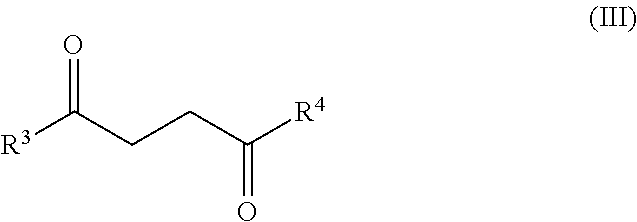Synthesis of diketone compounds from carbohydrates
- Summary
- Abstract
- Description
- Claims
- Application Information
AI Technical Summary
Benefits of technology
Problems solved by technology
Method used
Image
Examples
example 1 preparation
of HMHD from HMF Using a Solid Acid Catalyst in the Presence of Hydrogen and a Catalyst (H)
[0077]To a 5 mL THF / H2O (9:1) mixture containing 9.75 mg of Pd / C and 16.5 mg of Amberlyst® 15 (hereinafter abbreviated as “A15”), HMF (150 mg) was added. The thus obtained mixture was then placed inside a 45 ml autoclave and flushed with hydrogen. Subsequently, the autoclave was heated to 80° C. under a hydrogen pressure of 50 bar, for 15 hours. The reaction mixture was then let cool to room temperature, after which the reactor was vented and opened. A syringe filter was used to remove the solid catalysts from the reaction mixture, and the remaining liquid was analysed by GC using biphenyl as the internal standard. The HMF conversion was measured to be 100%, and the yield of HMHD was 77%.
[0078]The major co-product was LA, another 1,4-diketon compound, with 10% yield. Total carbon mass balance of this reaction reached 84%.
example 2 preparation
of HMHD from Fructose Using a Solid Acid Catalyst in the Presence of Hydrogen and a Catalyst (H)
[0079]To a 5 ml THF / H2O (9:1) mixture was added 250 mg Fructose, 16.25 mg Pd / C and 27.5 mg of A15 catalyst. The thus obtained mixture was then placed inside a 45 ml autoclave and flushed with hydrogen. Subsequently, the autoclave was heated to 80° C. under a hydrogen pressure of 20 bar, for 20 hours. The reaction mixture was then let cool to room temperature, after which the reactor was vented and opened. A syringe filter was used to remove the solid catalysts from the reaction mixture, and the remaining liquid was analysed by GC using biphenyl as the internal standard. The fructose conversation was measured to be 95%, and the yield of HMHD was 55%. The main co-products were LA and HMF, with 11% and 12% yield respectively. Total carbon mass balance of this reaction reached 82%.
Example 3 Preparation of HDX from DMF Using CO2 / H2O Catalyst
[0080]A 5 ml water solution of DMF (150 mg, 1.56 mmol...
example 9 preparation
of HMHD from Inulin Using a Solid Acid Catalyst in the Presence of Hydrogen and a Catalyst (H)
[0086]To a 5 ml THF / H2O (9:1) mixture was added 250 mg Inulin, 16.25 mg Pd / C and 27.5 mg of A15 catalyst. The thus obtained mixture was then placed inside a 45 ml autoclave and flushed with hydrogen. Subsequently, the autoclave reactor was heated to 80° C. under a hydrogen pressure of 20 bar, for 20 hours. The reaction mixture was then let cool to room temperature, after which the reactor was vented and opened. A syringe filter was used to remove the solid catalysts from the reaction mixture, and the remaining liquid was analysed by GC using biphenyl as the internal standard. The inulin conversation reached 95%, and the yield of HMHD was 36%.
PUM
 Login to View More
Login to View More Abstract
Description
Claims
Application Information
 Login to View More
Login to View More - R&D
- Intellectual Property
- Life Sciences
- Materials
- Tech Scout
- Unparalleled Data Quality
- Higher Quality Content
- 60% Fewer Hallucinations
Browse by: Latest US Patents, China's latest patents, Technical Efficacy Thesaurus, Application Domain, Technology Topic, Popular Technical Reports.
© 2025 PatSnap. All rights reserved.Legal|Privacy policy|Modern Slavery Act Transparency Statement|Sitemap|About US| Contact US: help@patsnap.com



